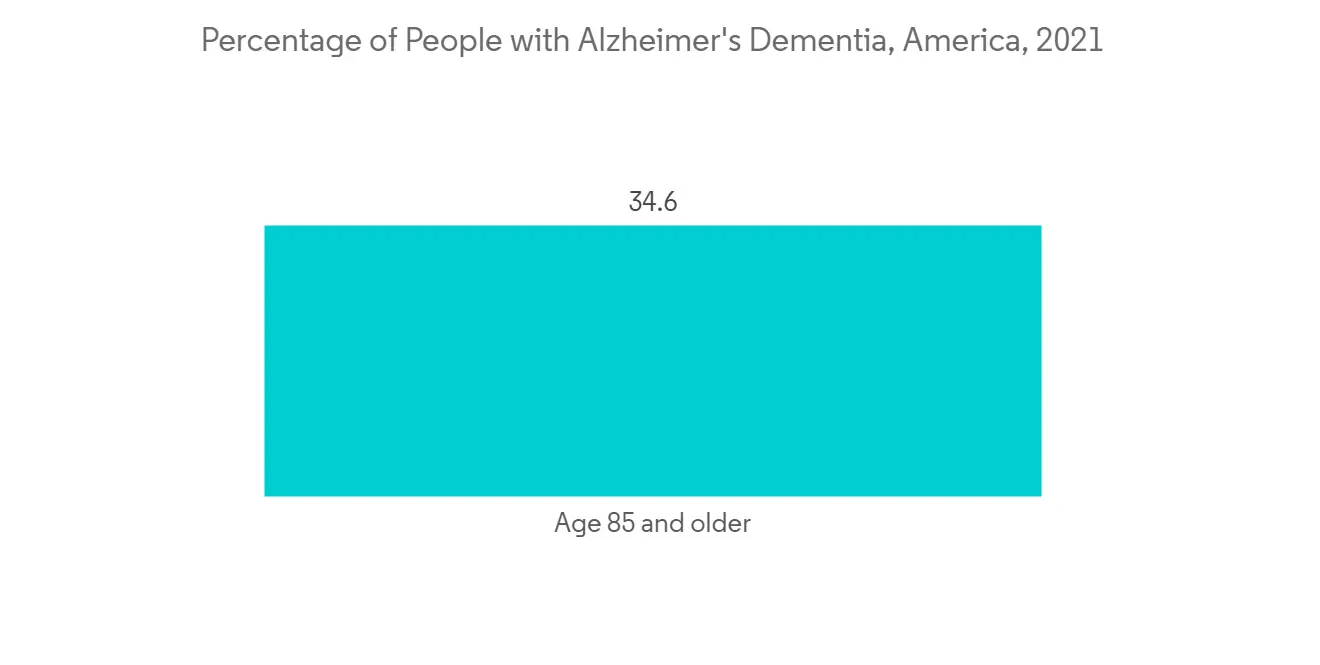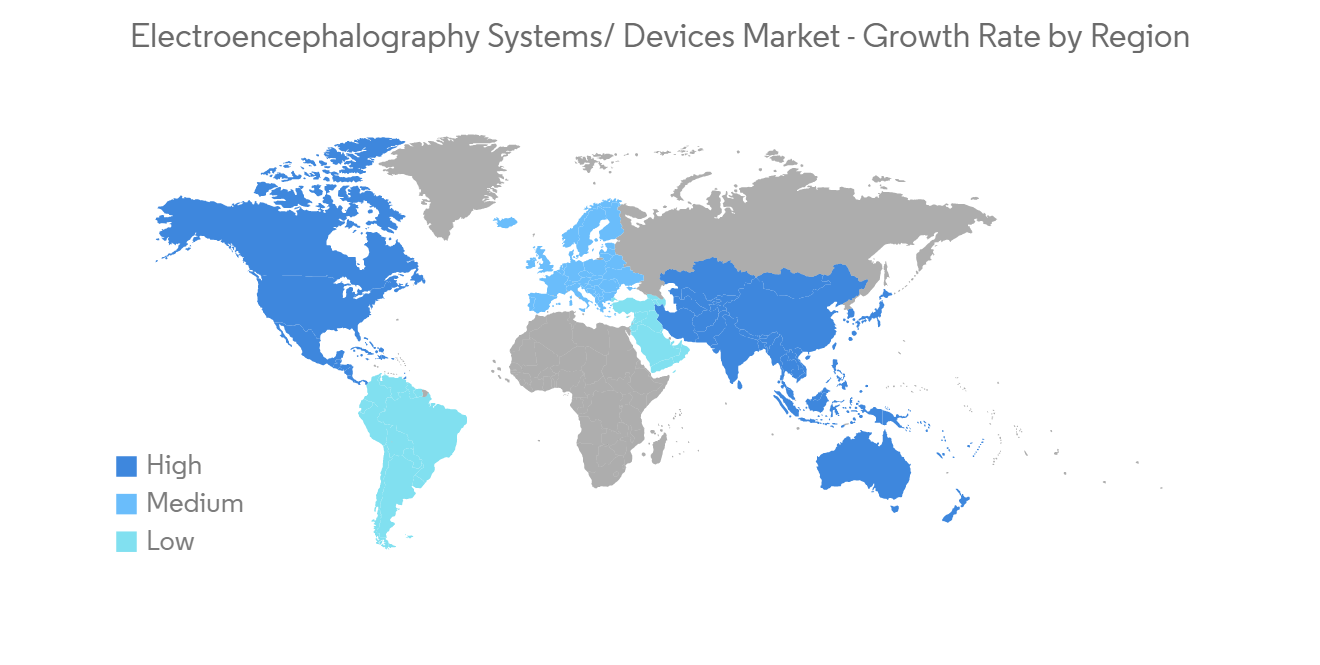 |
市場調査レポート
商品コード
1273316
脳波測定システム/デバイス市場- 成長、動向、予測(2023年-2028年)Electroencephalography Systems/Devices Market - Growth, Trends, and Forecasts (2023 - 2028) |
||||||
● お客様のご希望に応じて、既存データの加工や未掲載情報(例:国別セグメント)の追加などの対応が可能です。 詳細はお問い合わせください。
| 脳波測定システム/デバイス市場- 成長、動向、予測(2023年-2028年) |
|
出版日: 2023年04月14日
発行: Mordor Intelligence
ページ情報: 英文 117 Pages
納期: 2~3営業日
|
- 全表示
- 概要
- 目次
脳波測定システム機器市場は、予測期間中に8%のCAGRで推移すると予想されます。
COVID-19の事態は、神経学的サービスを含む医療サービスの大幅な再編成を必要としました。2021年1月に発表された「The impact of the COVID-19 pandemic on people with neurological disorders:an urgent need to improve the health care system's preparedness」という論文によると、スペイン、特にマドリード地域のデータでは、95%の病院がCOVID-19患者の支援に神経科医を再配分し、神経病棟のベッド数が89%削減されました。パンデミックは、特に病院と地域の一体化がすでに欠けている場所において、神経疾患患者に対する十分な医療が提供されていないことを露呈しました。COVID-19患者のための医療資源のシフトは、社会的距離を置く措置とともに、外来患者や入院患者、在宅介護の環境における神経リハビリテーションを危うくしています。しかし、現在、心臓疾患の増加により、世界的に脳波測定システムの使用が大幅に増加していることから、市場が活性化しつつあります。
脳波計は、アルツハイマー病患者の脳活動を確認し、皮質神経細胞機能を反映する唯一の臨床診断機器です。さらに、アルツハイマー型てんかん、多発性硬化症、認知症、パーキンソン病、脳卒中の発症率の高さが、この脳波計を採用する主な促進要因となっており、市場をさらに活性化させています。例えば、2020年3月からのパーキンソン財団の統計更新によると、2020年までに米国で100万人以上がパーキンソン病と共存しており、毎年6万人近くの米国人がパーキンソン病と診断されています。このように、世界的に神経疾患の発症率が高いことから、脳波測定システム/デバイス市場は予測期間中に大きく成長することが予想されます。
さらに、世界保健機関(WHO)が2021年10月に発表したデータでは、人口の高齢化のペースが従来よりもはるかに速く、2030年には世界の6人に1人が60歳以上となると報告されています。このとき、60歳以上の人口に占める割合は増加し、2050年には12%から22%へとほぼ倍増します。高齢化が健康上の問題、特に神経疾患の増加を生むため、入院患者数も増加すると予想されます。この入院が脳波システムの必要性につながり、脳波システム機器市場を牽引するものと思われます。
さらに、製品の発売や製品開拓の増加は、市場の成長を促進します。例えば、2022年8月、Myneurva社は、同社のAdvanced Neural Network Analysis(ANNA)の完全統合システムであり、50以上の研究ベースの脳トレーニングプログラムを備えたStarrbaseを発売しました。さらに、2022年2月、Masimoは、SedLine脳機能モニタリングとSedLine小児用EEGセンサーの小児適応の米国食品医薬品局認可を発表しました。このような要因は、世界中で脳波測定システム/デバイスを採用する需要を潜在的に後押ししています。
しかし、脳波測定システムの制限により、脳波測定システム/デバイス市場の成長が妨げられると予想されます。
脳波測定システム/デバイスの市場動向
スタンドアロン型脳波測定システムは今後健全な成長を遂げると予想される
腫瘍、脳卒中、脳性麻痺、その他の脳関連疾患などの神経疾患の増加により、スタンドアロン型システムは将来的に健全な成長を遂げると予想されています。これらの対象者は、これらのシステムが一般的に使用されている病院に入院する傾向が強いです。スタンドアロン型は、ハードウェアとソフトウェアで構成され、特定の場所に固定されるシステムで、病院で広く使用されています。このシステムは、医師やドクターが結果を効率的に解釈することを可能にし、クリティカルケアでの高い適用がセグメントの成長を後押ししています。
アルツハイマーの発症率は常に増加しており、今後数十年間も増加し続けると予想されています。世界保健機関の2021年9月の報告書によると、世界中で約5,500万人が認知症と共存しており、毎年1,000万件近くの症例が報告されています。同資料では、アルツハイマー型認知症が最も多く、認知症全体の約60~70%を占めるとされています。したがって、アルツハイマー病の発症率の高さは、予測期間中の同分野の大幅な成長に貢献すると予想されます。
さらに、アルツハイマー病協会の2021年3月の報告書によると、米国では65歳以上の約620万人がアルツハイマー病関連の認知症を抱えており、この数は2060年までに1,380万人に増加すると予測されています。さらに、同出典によると、米国におけるアルツハイマー病および認知症関連の死亡者数は、COVID-19のパンデミック時に16%増加しました。2021年には、アルツハイマー病やその他の認知症の発生費用として約3,550億米ドルを記録し、2050年にはこの金額が1兆1,000億米ドル以上になると予測されています。
したがって、前述のすべての要因が、予測期間中のセグメントの成長を後押しすると予想されます。

北米が市場において大きなシェアを占めると予想される
北米は、神経疾患の増加、睡眠障害の有病率の上昇により、世界の脳波測定システム機器市場で大きなシェアを占めると予想されます。
世界保健機関(WHO)および汎米保健機関(PAHO)の2020年調査によると、北米の半数以上の国(60.7%)で心理療法およびカウンセリングサービスの一部または全部が中断され、精神保健施設での診断および検査サービスは28カ国中11カ国(39.3%)で中断されました。調査によると、COVID-19は、南北アメリカ地域全体の精神・神経・物質使用(MNS)サービスにかなりの影響を与えたとされています。しかし、MNSサービスの種類とその中断の程度は大きく異なっています。外来患者や地域密着型サービス(主に在宅・デイケアサービス)は、ほとんどの国でかなりの影響を受けています。
米国国立精神衛生研究所(NIMH)の2020年版によると、米国の成人の4人に1人が、ある年に診断可能な精神障害を持ち、6%近くが重度の障害に苦しんでいると推定されています。また、米国における重度の精神疾患の総費用は、年間3,170億米ドルを超えると同資料は述べています。
さらに、米国食品医薬品局からの承認の増加や、主要プレイヤーによる製品の発売が市場を押し上げると予想されています。例えば、2021年11月、ブレインサイエンティフィック社は、STAT脳波の記録が望まれる日常的な臨床および研究環境において、迅速な脳波を得るために使用される高度な脳波(EEG)電極配列であるNext-Gen NeuroCap EEG Headsetの米国食品医薬品局の認可を取得しました。
さらに、ヘルスケア支出の増加と確立されたヘルスケアインフラの存在も、この地域の市場全体の成長を大きく後押ししています。

脳波測定システム/デバイス産業の概要
脳波測定システム/デバイス市場は細分化された競争市場であり、複数の大手企業で構成されています。現在、市場を独占している企業には、Natus Medical, Inc.、Cadwell Industries, Inc.、Medtronic、および日本光電工業株式会社があります。
その他の特典:
- エクセル形式の市場予測(ME)シート
- 3ヶ月間のアナリストサポート
目次
第1章 イントロダクション
- 調査の前提条件と市場定義
- 本調査の対象範囲
第2章 調査手法
第3章 エグゼクティブサマリー
第4章 市場力学
- 市場概要
- 市場促進要因
- 研究開発費の増加
- 神経疾患の有病率の増加
- 市場抑制要因
- 脳波計の限界
- ポーターのファイブフォース分析
- 新規参入業者の脅威
- 買い手/消費者の交渉力
- 供給企業の交渉力
- 代替品の脅威
- 競争企業間の敵対関係
第5章 市場セグメンテーション
- タイプ別
- 携帯型デバイス
- スタンドアロン型
- エンドユーザー別
- 病院
- 診断センター
- その他
- 地域別
- 北米
- 米国
- カナダ
- メキシコ
- 欧州
- ドイツ
- 英国
- フランス
- イタリア
- スペイン
- その他欧州
- アジア太平洋地域
- 中国
- 日本
- インド
- オーストラリア
- 韓国
- その他アジア太平洋地域
- 中東・アフリカ地域
- GCC
- 南アフリカ
- その他中東とアフリカ
- 南米
- ブラジル
- アルゼンチン
- その他南米
- 北米
第6章 競合情勢
- 企業プロファイル
- Natus Medical, Inc.
- NeuroWave Systems, Inc
- Cadwell Industries, Inc.
- Medtronic
- Nihon Kohden Corporation
- Advanced Brain Monitoring, Inc.
- Cephalon A/S
- Compumedics Limited
- Fresenius SE & Co. KGaA
- General Electric Company(GE Healthcare)
- Koninklijke Philips N.V.(Philips Healthcare)
第7章 市場機会および将来動向
The electroencephalography systems devices market is expected to register a CAGR of 8% over the forecast period.
The COVID-19 situation necessitated significant rearranging of health services, including neurological services. According to an article published in January 2021 titled "The impact of the COVID-19 pandemic on people with neurological disorders: an urgent need to improve the health care system's preparedness," data from Spain, particularly the Madrid area, show that 95% of hospitals have re-allocated neurologists to assist COVID-19 patients, and the number of beds in neurology wards has been reduced by 89%. The pandemic has exposed the lack of sufficient health care for patients with neurological illnesses, particularly in locations where hospital-community integration is already lacking. The shift in health resources for COVID-19 patients, along with social distancing measures, has jeopardized neuro-rehabilitation in the outpatient context and inpatient and home care settings. However, the market is currently gaining traction due to the significant increase in the use of electroencephalography devices globally due to the increasing number of heart diseases.
Electroencephalography is the only clinical diagnostic instrument to see brain activity and reflect cortical neuronal functioning in Alzheimer's patients. Moreover, high incidences of Alzheimer's epilepsy, multiple sclerosis, dementia, Parkinson's disease, and stroke are the key driving factors for adopting this electroencephalography, further triggering the market. For instance, as per the Parkinson's Foundation Statistics updates from March 2020, more than one million people were living with Parkinson's disease in the United States by 2020, and nearly 60,000 Americans are diagnosed with Parkinson's disease every year. Thus, because of the high incidence of neurological disorders globally, the electroencephalography system/devices market is expected to grow significantly over the forecast period.
Moreover, the data published in October 2021 by World Health Organization (WHO) reported that the pace of population aging is much faster than in the past, and 1 in 6 people worldwide will be 60 years or over by 2030. At this time, the share of the population aged 60 years and over will increase and will nearly double from 12% to 22% by 2050. As the aging population creates an increase in health-related issues, especially neurological diseases, the hospitalization of patients is also expected to rise. This hospitalization is likely to lead to the requirement for electroencephalogram (EEG) systems, and this is expected to drive the electroencephalography systems devices market.
Moreover, increasing product launches and product development promotes market growth. For instance, in August 2022, Myneurva launched Starrbase, a fully integrated system of its Advanced Neural Network Analysis (ANNA), with over fifty research-based brain training programs. Moreover, in February 2022, Masimo announced the United States Food and Drug Administration clearance of pediatric indication for SedLine brain function monitoring and the SedLine pediatric EEG sensor. Such factors potentially drive the demand for adopting electroencephalography systems/devices worldwide.
However, the limitation of the electroencephalography system is expected to hamper the growth of the electroencephalography systems/devices market.
Electroencephalography Systems/Devices Market Trends
Standalone Electroencephalography System is Expected to Witness a Healthy Growth in Future
The standalone system is expected to witness healthy growth in the future owing to an increasing number of neurological disorders such as tumors, strokes, cerebral palsy, and other brain-related disorders. These target populations are more prone to admit to hospitals wherein these systems are commonly used. A standalone system is fixed at a particular place consisting of hardware and software and is widely used in hospitals. This system allows doctors and physicians to interpret the results efficiently and high application in critical care is boosting the segment growth.
The incidence of Alzheimer's has constantly been increasing, and it is expected to continue increasing in the coming decades. According to the September 2021 report of the World Health Organization, about 55 million people around the world are living with dementia, and nearly 10 million cases are reported every year. As per the same source, Alzheimer's is the most common form of dementia and constitutes about 60-70% of the total cases of dementia. Thus, the high incidence of Alzheimer's disease is expected to help in the significant growth of the segment over the forecast period.
Furthermore, according to the March 2021 report of the Alzheimer's Association, approximately 6.2 million people of age 65 years and more are living with Alzheimer's-related dementia in the United States, and it is projected that this number will increase to 13.8 million people by 2060. Further, as per the same source, Alzheimer's- and dementia-related deaths in the United States increased by 16% during the COVID-19 pandemic. It was estimated that in 2021, the country recorded about USD 355 billion in Alzheimer's and other dementia incurred costs, and it is expected that by 2050, this amount would rise to more than USD 1.1 trillion.
Thus, all aforementioned factors are expected to boost segment growth over the forecast period.

North America is Expected to Hold a Significant Share in the Market
North America is expected to hold a major market share in the global electroencephalography systems devices market due to increasing incidences of neurological disorders, and the rising prevalence of sleep disorders.
According to the World Health Organization's (WHO) and Pan American Health Organization's (PAHO) 2020 survey, psychotherapy and counseling services were partially or wholly disrupted in more than half of North American countries (60.7%), while diagnostic and laboratory services at mental health facilities were disrupted in 11 of 28 countries (39.3%). COVID-19 has had a considerable impact on mental, neurological, and substance use (MNS) services throughout the Region of the Americas, according to the survey. However, the types of MNS services and the extent to which they have been disrupted differ significantly. Outpatient and community-based services (mainly home and daycare services) were impacted considerably in most countries.
According to the United States National Institute of Mental Health (NIMH) 2020, it has been estimated that one in four American adults have a diagnosable mental disorder in any given year, and nearly 6% suffer from severe disabilities. The same source has also stated that the total cost of severe mental illness in the United States exceeds USD 317 billion per year.
Moreover, increasing approvals from the United States Food and Drug Administration and product launches by key players are expected to boost the market. For instance, in November 2021, Brain Scientific received the United States Food and Drug Administration clearance for the Next-Gen NeuroCap EEG Headset, an advanced Electroencephalogram (EEG) electrode array used to obtain rapid EEGs in routine clinical and research settings where the recording of STAT EEGs is desired.
Furthermore, increasing healthcare expenditure and the presence of well-established healthcare infrastructure are also fueling the growth of the overall regional market to a large extent.

Electroencephalography Systems/Devices Industry Overview
The Electroencephalography Systems Devices Market is fragmented and competitive, and consists of several major players. Some companies currently dominating the market are Natus Medical, Inc., Cadwell Industries, Inc., Medtronic, and Nihon Kohden Corporation.
Additional Benefits:
- The market estimate (ME) sheet in Excel format
- 3 months of analyst support
TABLE OF CONTENTS
1 INTRODUCTION
- 1.1 Study Assumptions and Market Definition
- 1.2 Scope of the Study
2 RESEARCH METHODOLOGY
3 EXECUTIVE SUMMARY
4 MARKET DYNAMICS
- 4.1 Market Overview
- 4.2 Market Drivers
- 4.2.1 Rising R&D Expenditure
- 4.2.2 Increasing Prevalence of Neurological Disorders
- 4.3 Market Restraints
- 4.3.1 Limitation of Electroencephalography System
- 4.4 Porter's Five Force Analysis
- 4.4.1 Threat of New Entrants
- 4.4.2 Bargaining Power of Buyers/Consumers
- 4.4.3 Bargaining Power of Suppliers
- 4.4.4 Threat of Substitute Products
- 4.4.5 Intensity of Competitive Rivalry
5 MARKET SEGMENTATION (Market Size by Value - USD million)
- 5.1 By Type
- 5.1.1 Portable Device
- 5.1.2 Standalone Device
- 5.2 By End User
- 5.2.1 Hospitals
- 5.2.2 Diagnostic Centers
- 5.2.3 Others
- 5.3 Geography
- 5.3.1 North America
- 5.3.1.1 United States
- 5.3.1.2 Canada
- 5.3.1.3 Mexico
- 5.3.2 Europe
- 5.3.2.1 Germany
- 5.3.2.2 United Kingdom
- 5.3.2.3 France
- 5.3.2.4 Italy
- 5.3.2.5 Spain
- 5.3.2.6 Rest of Europe
- 5.3.3 Asia-Pacific
- 5.3.3.1 China
- 5.3.3.2 Japan
- 5.3.3.3 India
- 5.3.3.4 Australia
- 5.3.3.5 South Korea
- 5.3.3.6 Rest of Asia-Pacific
- 5.3.4 Middle-East and Africa
- 5.3.4.1 GCC
- 5.3.4.2 South Africa
- 5.3.4.3 Rest of Middle-East and Africa
- 5.3.5 South America
- 5.3.5.1 Brazil
- 5.3.5.2 Argentina
- 5.3.5.3 Rest of South America
- 5.3.1 North America
6 COMPETITIVE LANDSCAPE
- 6.1 Company Profiles
- 6.1.1 Natus Medical, Inc.
- 6.1.2 NeuroWave Systems, Inc
- 6.1.3 Cadwell Industries, Inc.
- 6.1.4 Medtronic
- 6.1.5 Nihon Kohden Corporation
- 6.1.6 Advanced Brain Monitoring, Inc.
- 6.1.7 Cephalon A/S
- 6.1.8 Compumedics Limited
- 6.1.9 Fresenius SE & Co. KGaA
- 6.1.10 General Electric Company (GE Healthcare)
- 6.1.11 Koninklijke Philips N.V. (Philips Healthcare)
